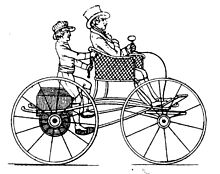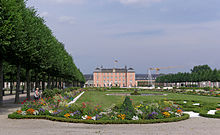Schwetzingen Palace



Schwetzingen Palace is a
History
Schwetzingen Palace is first mentioned in 1350, as a fort. It took the form of an ordinary
The palace received its current form at the command of Elector John William (1690–1716), who ruled from Düsseldorf. John William had it rebuilt under the direction of Count Matteo Alberti, who also oversaw the construction of Bensberg Castle, and the Heidelberg architect Johann Adam Breunig, and had it extended with two wings. The construction took place in several stages from 1697 onwards. For John William, the palace was not yet to be an official summer residence, but a simple hunting lodge. However, an ornate, if comparatively modestly scaled first garden was laid out at the same time, which was retained and embellished by Charles III Philip (1716-1742).
Under Charles IV Theodore (1742-1799), Schwetzingen was a

Pigage bought a phaeton driven by a footman from London in 1775 for Carl Theodore. In this vehicle, the elector could drive around the park without polluting the garden paths with dung from horses. To allow this vehicle to travel easily around the garden, all the main routes were levelled and a prehistoric grave mound was removed. The vehicle, now located at Nymphenberg Palace was an inspiration to Heidelberg student Karl Drais in his invention of the velocipede (a precursor of the bicycle).[1]
The third court gardener,
Today, Schwetzingen Palace is a state-owned heritage monument, cared for by the institution of the State Palaces and Gardens of Baden-Württemberg. The garden is publicly accessible, while tours are led through the Palace and Theatre.
Palace

The palace's axis sits on a line running from the
Interior
Much of the original interior decoration and furnishings survive. Following a major restoration effort between 1975 and 1991, several of the electoral and ducal apartments were renovated and outfitted with authentic 18th century furniture. These rooms may not have the supreme splendour found elsewhere in German princely dwellings, but they do convey a particularly vivid image of the court's everyday life. The piano nobile contains the common rooms, the residences of the electors and the electors' wives. It is now a museum explaining the operation of the Palace in the time of Charles Theodore. The rooms of the residence of the countess Louise Caroline of Hochberg on the second floor, which were remodelled after 1803, are particularly significant because of the survival of the hand-printed wallpaper made by Zuber & Cie in 1804.
Zirkelbauten

The main building was too small to accommodate the reception rooms required for court social events (feasts, games, concerts, and balls). Thus, two large halls and a theater were instead incorporated into two symmetrical curved outbuildings (the Zirkelbauten) on the garden side, which had initially been intended to serve only as

Theatre
Schwetzingen Palace and garden
Much like the gardens, the theatre is in many ways a synthesis of conflicting styles. Originally built in 1753, to the plans of Nicolas de Pigage (1723–1796) and in a very short time, it could be considered a pure rococo creation. In the course of a later refurbishment, this was blended with early neoclassical tendencies. In its first state, the theatre, following the example of French court theatres of the time, did not have boxes (these were a staple of "Italian" theatres). In order to enlarge it, the auditorium's back wall was then pierced with a row of arcades, thus creating a more "box-like" impression. As a result, the theatre can, at least visually, also be considered a combination of the customary "French" and "Italian" layouts, even if the adjustment was, in this case, made mostly for practical reasons. As with the garden, the overall effect is very homogeneous as well as esthetically pleasing. Well into the 20th century, the theatre had preserved its original stage machinery. This was then lost and replaced with modern facilities, first in the 1950s, and again in the 1970s, when the backstage area was also expanded.
-
Theatre, stage
-
Theatre, auditorium
Gardens


During the second half of the 18th century, when the current Schwetzingen garden was created, the "French"
The first plan, devised by the gardener Petrie of Zweibrücken, introduced one highly unusual motif, namely laying out the main parterre as a full circle. This remains unchanged and is a prominent feature that distinguishes Schwetzingen from most contemporary creations. Other than that, the first design was fairly conventional, even somewhat antiquated, in character. It appears to have relied heavily on French theorist Dezallier d'Argenville's influential textbook Théorie et practique du jardinage.
Under the auspices of Nicolas de Pigage, the garden's plan was updated and expanded, while preserving most of its original features. Unlike his predecessor, Pigage was familiar with the latest developments in style. Most of the designs he prepared for Schwetzingen were progressive and up-to-date. However, not all of them were carried out, and as time progressed, the prince's (and possibly also the architect's) reluctance to make a full switch towards the "English" style provoked critical scorn (most notably from the garden-design theorist Christian Cay Lorenz Hirschfeld[2]). Only the fabriques that Pigage built in various parts of the garden were exempt from Hirschfeld's criticism. The outstanding architectural quality of these small, yet elaborate, buildings was universally acknowledged (Hirschfeld, in fact, objected mostly to their number – he would have preferred fewer of them). On the newer, more fully developed landscaped portions, Pigage collaborated closely with the up-and-coming garden designer Friedrich Ludwig von Sckell.
The sculpture throughout the garden is of varied quality, including some notable works by
French garden


The
English garden
The western and northwestern parts of the garden were laid out as an English landscape garden. Unlike the French garden, the paths and shorelines in this part of the garden are slightly irregular. The forested parts of the garden were left almost unchanged.
Lake
The great lake at the far end of the garden is visible from the palace entrance. The location of the lake was originally a walled pool, which Grand Duke Louis of Baden had expanded in 1823, at the suggestion of Zeyher, transforming it into a lake with a natural shoreline. Copies of two sculptures by Verschaffelt lie on the long side of the lake facing the palace, on either side of the main axis: the river gods Rhine and Danube. The original sculptures are now displayed in the orangery.
The lake and all the other water features have been supplied from two waterworks, since the time of Pigage, which use the

Buildings
The garden contains several structures. The building programme makes philosophical and architectural references to
According to
Temple of Minerva

The Roman goddess
A statue of Minerva, goddess of wisdom, stands at the back wall. It is a reworked version of a work by
Underneath the temple is a rectangular room with niches and round windows. This room is accessible from the back of the temple and shows signs of being a secret meeting place. It is dominated by
A temple of Cupid was planned to stand opposite the temple of Minerva in symmetry with it, but this was never realised.
Mosque
The
After many years of restoration, and at great expense, the mosque is fully restored and open to the public.
-
View of the Schwetzingen Mosque
-
View of the Mosque
-
Interior
Temple of Mercury

A "monument" was already planned to go opposite the mosque in the "parties sauvages", the southwestern landscape section of Schwetzinger garden, in 1784. An artificial ruin was built by Pigage in 1787 and 1788, which is first referred to as a temple for the Roman god Mercury in 1791. Its cellar-like foundations are built from large sandstone blocks, and appear to be the remains of an earlier precursor. The temple is three stories high and topped by a tower. It is made from tuff stone. The groundplan consists of a hexagonal main floor, with an attic floor above, and a lantern on top of that. There are marble reliefs depicting Mercury above the entrances of three identical facades.
The mainstream interpretation of the structure is that it is a message about transcending mysticism through reason. This interpretation notes that the temple has the form of a Roman mausoleum. It connects the three reliefs, which exclusively depict negative episodes from the life of Mercury, with the ancient
Practically, the temple functions as a viewing point, with the upper level providing a clear line of sight over the lake and towards the mosque.
Notes
- ^ Hans-Erhard Lessing: Zwei Räder statt vier Hufe – Karl Drais G.Braun-Verlag, Karlsruhe 2010
- ^ Wolfgang Schepers, "C. C. L. Hirschfelds Theorie der Gartenkunst ( I779-85) und die Frage des 'deutschen Gartens'", in Park und Garten im 18 Jahrhundert 1976.
- ISBN 978-3-942187-43-5.
- ^ Richard Benz: Heidelberg. Schicksal und Geist, Jan Thorbecke Verlag Sigmaringen, 2. Auflage 1975, ISBN 3-7995-4008-3, S. 296
- ^ Baguette, Friedhelm (19 June 2007). "Architecture and Migration: Germany". Startseite ghs-mh.de. Retrieved 24 January 2023.
- ^ "The Mosque". schloss-schwetzingen.de. Schwetzingen Palace official website.
- ISBN 978-3-942187-43-5.
References
- Fuchs, Carl Ludwig; Reisinger, Claus (2001). Schloss und Garten zu Schwetzingen (in German). Worms: Wernersche Vlgsg. OCLC 46966854.
- Zenkner, Oswald (2002). Schwetzinger Schlossgarten [ein Führer durch das französische Gartenparterre und den englischen Landschaftsgarten ; mit Informationen über Schloss und Rokokotheater sowie Sehenswürdigkeiten der Umgebung] (in German). Schwetzingen. )
- Wiltrud Heber (1986). Die Arbeiten des Nicolas de Pigage in den ehemals kurpfälzischen Residenzen Mannheim und Schwetzingen Teil 1 (in German). Worms. )
- Dennerlein, Ingrid (1981). Die Gartenkunst der Régence und des Rokoko in Frankreich (in German). Worms: Werner'sche Verlagsgesellschaft. OCLC 9446723.
External links
- Official website
- Information about and photos of the theatre
- (in German) Homepage (in English) Website with a growing collection of images about Schwetzingen Palace







